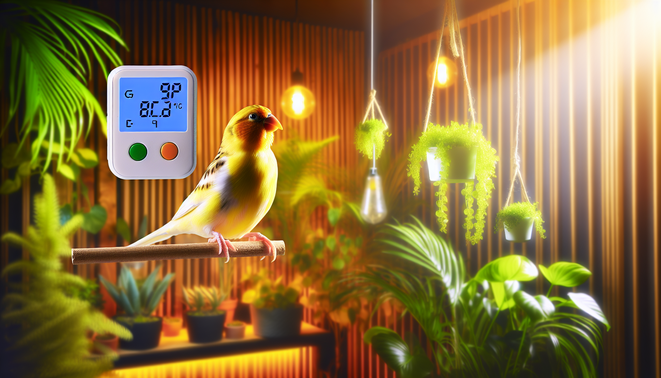“`html
Creating a Comfortable Habitat for Your Canary
Creating a comfortable habitat for your canary is essential for its health and happiness, with two critical factors to consider: lighting and temperature.
Lighting
Canaries thrive in bright environments, but direct sunlight can be overwhelming. Ideally, position the cage in an area that receives indirect natural light, supplemented by high-quality artificial light for about 12-14 hours daily. This schedule mimics their natural habitat, promotes healthy activity patterns, and stimulates their singing behavior. Full-spectrum bulbs that emit UVA and UVB rays are particularly beneficial, as studies suggest that exposure to these wavelengths positively influences their mood and behavior [Source: PetMD].
Temperature
The ideal temperature for canaries ranges from 65°F to 75°F (18°C to 24°C). Avoid placing their habitat near drafts, heating vents, or in locations where temperatures fluctuate significantly. Maintaining a stable environment is crucial, as extreme temperatures can lead to stress or illness. Additionally, keep humidity levels around 40-60%, since dry air can cause respiratory problems [Source: The Spruce Pets].
By managing your canary’s lighting and temperature carefully, you foster a nurturing space that supports their health, happiness, and vibrant spirit. For additional insights on nurturing your birds, check our article on effective song training.
Natural Light
Natural sunlight is the best source of vitamin D for canaries, essential for calcium absorption and bone health. Exposure to sunlight enhances their mood, encourages singing, and promotes breeding behaviors. Ideally, your canary should receive several hours of direct sunlight each day, especially in the morning when light intensity is lower. If indoors, place the cage near a window that receives ample sunlight but is shielded from drafts or direct heat from radiators [Source: NCBI].
Artificial Lighting
If natural light is limited, artificial lighting can effectively replicate sunny conditions. Use full-spectrum bulbs that mimic natural daylight, especially beneficial during winter months when sunlight is scarce. Ensure your canary is exposed to about 12 to 14 hours of light daily to maintain their circadian rhythms and stimulate natural behaviors. Avoid standard incandescent bulbs, which do not provide the necessary light spectrum that canaries need [Source: My Pet Chicken].
Seasonal Adjustments
Canaries are especially sensitive to seasonal changes. In winter, maintain a warm living space ideally between 68°F and 75°F (20°C to 24°C) and cover the cage with a blanket at night for extra warmth. During summer, ensure good ventilation and provide cooling options, such as shallow water bowls for bathing, that help maintain their feathers’ condition (Source: PetsnPlants).
Behaviorally, canaries may sing more in spring, associating this time with mating season. Offering a quiet, comfortable environment with plenty of interaction encourages them to sing freely. Keep their space enriched with toys and perches to reduce anxiety as seasons shift (Source: PetsnPlants).
Monitoring Health and Behavior
Improper lighting and temperature conditions can significantly impact your canary’s health and well-being. Fluctuations in temperature can lead to stress and health complications. Maintain a consistent temperature within 65°F to 75°F (18°C to 24°C) and provide gradual changes when transitioning environments to avoid shock [Source: Petsnplants].
Lighting is equally crucial; canaries require 12 hours of light and 12 hours of darkness daily. Inadequate lighting can lead to depression and inactivity, negatively affecting their song and overall happiness. Utilize full-spectrum lighting placed in areas that avoid direct sunlight to prevent overheating [Source: Petsnplants].
Creating a Bird-Friendly Space
Designing a bird-friendly environment focuses on lighting, temperature management, mental stimulation, and safety. Here are practical tips:
- Natural Light Exposure: Position your birdcage near windows for sunlight while avoiding prolonged direct exposure [Source: PetsNPlants].
- Stable Environment: Maintain a room temperature between 65°F to 75°F (18°C to 24°C), ensuring birds are not near drafts or heaters [Source: PetsNPlants].
- Mental Stimulation: Include various toys that promote foraging, problem-solving, and physical activity. Rotate toys regularly to keep your bird engaged [Source: PetsNPlants].
- Avoid Toxicity: Ensure nearby plants are not toxic to birds; conduct thorough research before introducing new decor [Source: PetsNPlants].
By applying these thoughtful strategies, you’ll create a nurturing and bird-friendly atmosphere that fosters health, engagement, and safety for your avian companions.
Conclusion
Creating the perfect environment for your canary involves careful consideration of both lighting and temperature. Canaries prosper in bright but indirect light, and ideally, their cage should be placed near a window to enjoy natural light without harsh rays. Maintaining a warm environment is vital; keeping temperatures stable will ensure comfort and health.
We encourage you to share your experiences! How do you manage lighting and temperature for your canary? What tips have you found helpful? Together, we can foster a community of support and learning. Let’s share insights to provide the best care possible for our avian companions. For more information about caring for birds, check out our detailed article on nurturing your parrots’ voice.
Sources
- AnimalWised – How to Care for a Canary
- Canary Tales – Natural Light for Canaries
- NCBI – Natural Sunlight’s Impact on Birds
- My Pet Chicken – Lighting for Chickens: What You Need to Know
- PetMD – Birds and Sunlight
- The Spruce Pets – Canary Care and Housing Guide
- PetsnPlants – Creating a Loving Habitat for Your Hedgehog
- PetsnPlants – How to Nurture Your Parrots’ Voice
- PetsnPlants – Empowering Your Canary: Heartfelt Tips for Effective Song Training
“`
